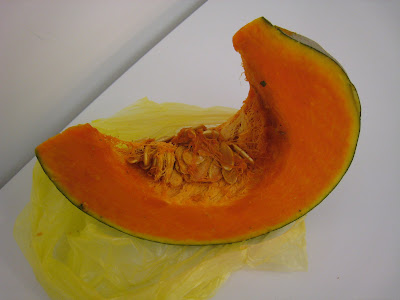
There is a special snack eaten in these parts around this time of year that is made from pure pork fat. Yup. Just plain old fat. The snack is called CVARCI
(Čvarci pronounced chvartzy) and involves pork fat getting cut into cubes, deep fried, pressed, dried out, then eaten usually at room temperature with a bit of salt. Normally, people add a bit of milk to the hot oil to give the cvarci their golden brown color, but I can't handle the milk, and often can't eat cvarci prepared by others because there's a great chance of gluten cross-contamination due to the incredibly delicious pairing of crusty bread with the cvarci. So, if I want to eat these yummy snacks, I need to make my own (no bread for moi.)
Here's the recipe. Method. And pictures.
Ingredients:
Pork fat
Equipment:
Big pot
Slotted spoon
Potato ricer (also known as a squeezer)
Big bowl lined with paper towel
Large pan lined with paper towel
A special note: DO NOT EAT these in large quantities. There's a seeeeeeerious amount of fat and cholesterol in these babies. One handful is good as a serving. Also, DO NOT add salt to these until you are about to eat them because the salt will make them rather rubbery and kinda mushy. Only add salt to the handful (one handful) that you are eating.
Here's what the pork fat looks like. These pieces weigh about 2 pounds or 1 kg each. I bought 5kg for my session. Make sure that the skin has been removed.


The fat is about 1 inch or about 3cm thick.

Slice the fat into strips about 2 inches or 3 cm across. Then cut those strips into cubes about 2 inches or 3 cm. Don't worry if some are slightly bigger or smaller.

Put all the cubes into a cold, empty big pot. My pot holds 8 litres, and I filled it to the 6 litre line. Don't over-fill because you need to leave quite a bit of room for the fat to render out, and bubble up.

Once you have all your fat cut up into cubes, and you've put all your cubes into your pot, move the pot to your heat source, and put the heat up to about medium. You'll have to watch the heat constantly and adjust accordingly to keep this to a medium heat. Don't let it get too hot or else everything will burn. Using a large spoon or spatula, keep turning the cubes so that they don't stick to the bottom. It'll look like this:

Keep turning them, and after about 15 minutes, you'll be able to see the fat bubbling up like this:

Keep turning the cubes. They will start to brown. And they'll look like this after just another 5 or 6 minutes:

Until finally they will get really golden brown (but not burnt!) and they will float to the top like this.:

Using a slotted spoon, carefully scoop out the cubes and put them into a big bowl that is lined with paper towel to soak up some of the oil.

Now, you've got to scoop 5 or 6 cubes into the squeezer. Hold the squeezer over an empty bowl, and squeeze out as much oil as you can. Be careful because the oil will be very hot.

Then open the squeezer, and using a fork, loosen the flattened cubes, and shake out onto a large pan lined with paper towels. Remember DO NOT salt these.

In batches of 5 or 6 cubes, squeeze the oil out of all the cubes. Shake all your squeezed cubes onto the paper-towel-lined pan, leave the pan out on a table and let everything cool down and dry somewhat. You can eat the cvarci at this point...however, it is best to let them cool right down to room temperature for best results. In about an hour, they'll look like this and be ready to eat:


Once all cooled down (after a couple of hours), put the cvarci in a ziploc bag or in a container and keep them in the refrigerator. I've kept them for 2 weeks in the fridge with no problems.
Enjoy!


























